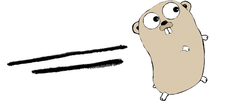Go version 1 series
Well Executed

© Lead Image CC BY-SA 3.0
The Go programming language helps programmers avoid the annoying routine and focus on the important stuff.
In 2009, Google launched the Go programming language [1]. An impressive collection of veteran developers worked on Go, including Ken Thompson (one of the inventors of Unix), Plan 9 co-creator Rob Pike, and Rob Griesemer, who previous worked on Google projects such as the Smalltalk variant Strongtalk.
The goal of Go was to create a statically typed language similar to C, but with updated features such as garbage collection and better type safety. In addition to its trademark CSP (Communicating Sequential Processes) [2] concurrency solution, the influences of Limbo [3] and Inferno [4] are evident.
Early versions of Go evolved at a rapid pace, with the code changing so fast that applications written one week would no longer compile in later versions. Finally, in 2012, Go 1.0 was released with the promise that you would be able to compile any code in future versions of the 1.x series. Since then, the focus of the Go developers has been on tools, compilers, and the run time.
[...]
Buy this article as PDF
(incl. VAT)
Buy Linux Magazine
Subscribe to our Linux Newsletters
Find Linux and Open Source Jobs
Subscribe to our ADMIN Newsletters
Support Our Work
Linux Magazine content is made possible with support from readers like you. Please consider contributing when you’ve found an article to be beneficial.

News
-
Manjaro 26.0 Primary Desktop Environments Default to Wayland
If you want to stick with X.Org, you'll be limited to the desktop environments you can choose.
-
Mozilla Plans to AI-ify Firefox
With a new CEO in control, Mozilla is doubling down on a strategy of trust, all the while leaning into AI.
-
Gnome Says No to AI-Generated Extensions
If you're a developer wanting to create a new Gnome extension, you'd best set aside that AI code generator, because the extension team will have none of that.
-
Parrot OS Switches to KDE Plasma Desktop
Yet another distro is making the move to the KDE Plasma desktop.
-
TUXEDO Announces Gemini 17
TUXEDO Computers has released the fourth generation of its Gemini laptop with plenty of updates.
-
Two New Distros Adopt Enlightenment
MX Moksha and AV Linux 25 join ranks with Bodhi Linux and embrace the Enlightenment desktop.
-
Solus Linux 4.8 Removes Python 2
Solus Linux 4.8 has been released with the latest Linux kernel, updated desktops, and a key removal.
-
Zorin OS 18 Hits over a Million Downloads
If you doubt Linux isn't gaining popularity, you only have to look at Zorin OS's download numbers.
-
TUXEDO Computers Scraps Snapdragon X1E-Based Laptop
Due to issues with a Snapdragon CPU, TUXEDO Computers has cancelled its plans to release a laptop based on this elite hardware.
-
Debian Unleashes Debian Libre Live
Debian Libre Live keeps your machine free of proprietary software.

